Microsoft, Google highlight LLM capabilities for future growth
Satya Nadella and Sundar Pichai both touted the advancements their respective companies have made in the field of generative AI during their earnings calls.

Late last year, OpenAI released a chatbot called ChatGPT, which was built on a large language model (LLM) called GPT-3. GPT stands for Generative Pre-trained Transformer, and while GPT-3 wasn’t a new AI tool—OpenAI released it in 2020—the unveiling of ChatGPT has led to an arms race amongst the leading Big Tech companies.
During its earnings call last week, IBM touted its Watsonx offering, an enterprise-ready AI and data platform. “In the same way we’ve built a consulting practice around Red Hat’s hybrid cloud platform that is now measured in the billions of dollars, we will do the same with AI. And just like OpenShift is the technology platform at the heart of our hybrid cloud capabilities, Watsonx will be the core technology platform for our AI capabilities,” said IBM chairman and CEO Arvind Krishna during the company’s Q2 conference call.
Yesterday, July 25, Microsoft and Google took to the earnings call stage to tout their generative AI wares.
Satya Nadella, Microsoft’s chairman and CEO, highlighted the company’s army of Copilot solutions during the company’s Q4 earnings call, with its fiscal year ending June 30. Copilot is powered by GPT-4, the newest GPT version released by OpenAI, in which Microsoft invested $10 billion at the start of this year, building on a $1 billion investment from 2019. At the heart of Microsoft’s Copilot plans is one built specifically for Microsoft 365, which was unveiled in March.
“We are now rolling out Microsoft 365 Copilot to 600 paid customers through our early-access program, and feedback from [those users] is that it’s a game changer for employee productivity,” Nadella said. It’s an interesting proposition, perhaps especially for a company like LSEG, which is looking to incorporate Microsoft’s tools into its Workspace platform.
When asked by an analyst how Microsoft views the Copilot offering in context to the rest of its platforms, Nadella said executives “think of [it] like a third pillar, like we thought about Teams or SharePoint back in the day.”
“We had the creation tools, we then had all of the communication and collaboration services, and we think the AI Copilot is a third pillar. … Amy [Hood, Microsoft’s CFO] talked about how we want to get it out first and out of this preview, and then in the second half of the next fiscal year we’ll start getting some of the real revenue signals from it.” (It should be noted that neither Nadella nor Hood nor any of the investors asking questions on the call brought up the lawsuit working its way through the court system that could ensnare Microsoft, OpenAI, and GitHub’s efforts in the space.)
Meanwhile, during Alphabet’s Q2 earnings call, which started 30 minutes before Microsoft’s, Sundar Pichai spotlighted Bard, the company’s chatbot counterpart to ChatGPT.
“Since launching in March, [Bard] continues to get better. We rolled out a number of exciting features and capabilities earlier this month. Bard is now available in most of the world and in over 40 of the most widely-spoken languages,” said Pichai, CEO of Google. “We continue to see great interest in using Bard for coding tasks.”
A new era
While bank compliance officers have been pushing back on the spread of chatbots, the Big Tech firms are seeing dollar signs when it comes to generative AI. Like other cutting-edge forms of AI, capital markets firms are rarely early adopters, at least compared to industries like military, healthcare, and retail. But in the capitalistic capital markets, it’s only a matter of time before generative AI sweeps through.
“Every customer I speak with is asking not only how, but how fast they can apply next-generation AI to address the biggest opportunities and challenges they face, and to do so safely and responsibly,” Nadella said.
But one thing that Nadella emphasized on the call was the need for firms to first get their data in order—which plays right into the Big Tech players’ cloud businesses.
“Every AI app starts with data and having a comprehensive data [strategy], and [an] analytics platform is more important than ever. Our intelligent data platform brings together operational databases, analytics, and governance so organizations can spend more time creating value and less time integrating their data estate,” Nadella said, pointing to Microsoft Fabric, which was released at the end of May and unifies compute, storage and governance. “One month in, we are encouraged by early interest and usage—over 8,000 customers have signed up to trial the service and are actively using it, and over 50% are using four or more workloads.”
He also said that having a firm’s data in the cloud “is key to being able to take advantage of these new AI reasoning engines to compliment your databases.”
While capital markets firms are clearly aiming future development efforts toward the cloud, most non-born-in-the-cloud companies still have a long way to go with their migration projects.
“These AI engines are not databases, but they can reason over your data and then help you to get more insights, more completions, more predictions, more summaries and what have you. Those are the things—when we say Copilot design patterns—that’s what that design pattern is all about,” he said.
Pichai shared similar sentiments.
“Our AI-optimized infrastructure is a leading platform for training and serving generative AI models,” he said. “We are seeing strong demand for more than 80 models, including third-party and popular open-source [tools] in our Vertex, Search and conversational AI platforms, with a number of customers growing more than 15x from April to June.”
Further reading
Only users who have a paid subscription or are part of a corporate subscription are able to print or copy content.
To access these options, along with all other subscription benefits, please contact info@waterstechnology.com or view our subscription options here: http://subscriptions.waterstechnology.com/subscribe
You are currently unable to print this content. Please contact info@waterstechnology.com to find out more.
You are currently unable to copy this content. Please contact info@waterstechnology.com to find out more.
Copyright Infopro Digital Limited. All rights reserved.
You may share this content using our article tools. Printing this content is for the sole use of the Authorised User (named subscriber), as outlined in our terms and conditions - https://www.infopro-insight.com/terms-conditions/insight-subscriptions/
If you would like to purchase additional rights please email info@waterstechnology.com
Copyright Infopro Digital Limited. All rights reserved.
You may share this content using our article tools. Copying this content is for the sole use of the Authorised User (named subscriber), as outlined in our terms and conditions - https://www.infopro-insight.com/terms-conditions/insight-subscriptions/
If you would like to purchase additional rights please email info@waterstechnology.com
More on Emerging Technologies
Quants look to language models to predict market impact
Oxford-Man Institute says LLM-type engine that ‘reads’ order-book messages could help improve execution
The IMD Wrap: Talkin’ ’bout my generation
As a Gen-Xer, Max tells GenAI to get off his lawn—after it's mowed it, watered it and trimmed the shrubs so he can sit back and enjoy it.
This Week: Delta Capita/SSimple, BNY Mellon, DTCC, Broadridge, and more
A summary of the latest financial technology news.
Waters Wavelength Podcast: The issue with corporate actions
Yogita Mehta from SIX joins to discuss the biggest challenges firms face when dealing with corporate actions.
JP Morgan pulls plug on deep learning model for FX algos
The bank has turned to less complex models that are easier to explain to clients.
LSEG-Microsoft products on track for 2024 release
The exchange’s to-do list includes embedding its data, analytics, and workflows in the Microsoft Teams and productivity suite.
Data catalog competition heats up as spending cools
Data catalogs represent a big step toward a shopping experience in the style of Amazon.com or iTunes for market data management and procurement. Here, we take a look at the key players in this space, old and new.
Harnessing generative AI to address security settlement challenges
A new paper from IBM researchers explores settlement challenges and looks at how generative AI can, among other things, identify the underlying cause of an issue and rectify the errors.







